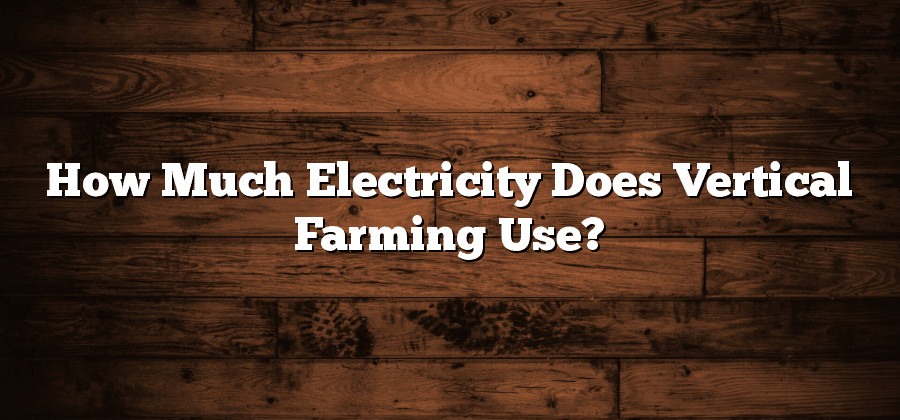An Overview of Vertical Farming’s Electricity Usage
Vertical farming is a promising approach to agricultural production that aims to address critical challenges such as limited land availability and climate change. However, one crucial aspect often overlooked is its electricity usage. Given the reliance on artificial lighting, heating, ventilation, and irrigation systems, vertical farms consume a substantial amount of energy. This reliance on electricity poses several economic and environmental implications that need to be carefully considered.
The primary cause of high electricity usage in vertical farms is the need for artificial lighting to facilitate plant growth. Most plants require specific light spectrums and durations for optimal growth, which are provided by energy-intensive LED lights. These lights, although highly efficient in converting electricity into light, still contribute significantly to the overall energy consumption of vertical farms. Additionally, heating, ventilation, and irrigation systems consume electricity, further adding to the energy demand. Considering the exponential growth in the number of vertical farming operations globally, it becomes crucial to scrutinize and optimize electricity usage for long-term sustainability and cost-effectiveness.
The Impact of Lighting Systems on Vertical Farm Energy Consumption
Vertical farming has gained significant attention in recent years for its potential to revolutionize the way we produce food. One key factor that can significantly impact the energy consumption of vertical farms is the lighting systems used. As crops in vertical farms grow indoors without natural sunlight, artificial lighting becomes essential for their photosynthesis process. However, the type and intensity of lighting systems can greatly influence the amount of energy consumed in these facilities.
Traditional lighting systems, such as high-pressure sodium (HPS) lights, have commonly been used in vertical farms due to their affordability and effectiveness. However, these lights have been found to consume a significant amount of energy, leading to higher electricity bills for vertical farm operators. As a result, many vertical farms are now transitioning towards more energy-efficient alternatives, such as light-emitting diode (LED) lights. LED lights have proven to be highly efficient in converting electrical energy into light, resulting in lower energy consumption and reduced operational costs for vertical farms. Additionally, LED lights can be customized to emit specific wavelengths of light, optimizing the growth and yield of different crop varieties.
Optimizing HVAC Systems for Efficient Energy Usage in Vertical Farms
HVAC systems play a crucial role in optimizing energy usage in vertical farms. These systems are responsible for controlling the temperature, humidity, and airflow within the facility to create the ideal growing conditions for plants. However, they can also be a significant source of energy consumption if not properly managed and optimized.
One way to improve the energy efficiency of HVAC systems in vertical farms is by implementing smart controls and monitoring systems. By using sensors and advanced algorithms, these systems can continuously monitor the environmental conditions and adjust the HVAC settings accordingly. For example, during periods of lower plant growth activity, when less cooling or heating is required, the system can automatically adjust the temperature setpoints to conserve energy. Similarly, by analyzing real-time data on humidity levels, the system can optimize the operation of dehumidification equipment to minimize energy wastage.
The Role of Water and Nutrient Management in Electricity Consumption
When it comes to vertical farming, water and nutrient management plays a crucial role in not only the overall success of the crops but also in the electricity consumption of the farm. Efficient management of water and nutrients can significantly reduce the need for additional resources, leading to lower energy requirements.
One method of optimizing water and nutrient management is through the use of hydroponic systems. These systems allow for the precise control and delivery of water and nutrients directly to the plants, eliminating the need for excessive watering or fertilizing. By providing the exact amount of water and nutrients needed, farmers can ensure that there is minimal waste or runoff, ultimately reducing the energy required for water pumping and filtration systems. Additionally, hydroponic systems can also be paired with recirculating systems, further minimizing water and nutrient waste and resulting in even greater energy savings.
Assessing the Energy Requirements of Vertical Farming Equipment
As the popularity of vertical farming continues to rise, it becomes increasingly important to assess the energy requirements of the equipment used in these systems. From LED lighting to HVAC systems, each component has a direct impact on the overall energy consumption of a vertical farm. By understanding and evaluating the specific energy needs of the equipment, farmers can make informed decisions about their setup and optimize energy usage for both economic and environmental sustainability.
LED lighting, in particular, plays a crucial role in vertical farming. These energy-efficient lights are designed to provide the optimal spectrum and intensity of light necessary for plant growth. However, it is important to consider the power consumption of LED fixtures and their impact on overall energy usage. By conducting a thorough assessment of lighting requirements, farmers can determine the ideal number and placement of fixtures to achieve desired yields while minimizing energy consumption. Additionally, investing in energy-efficient LED technology can save substantial amounts of electricity in the long run.






